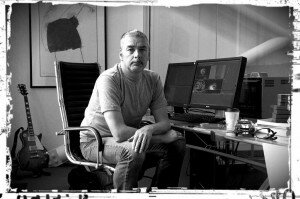 In the basement of Auckland Hospital’s Regional Cancer & Blood Services building are six identical rooms. The rooms are large, perhaps seven meters on a side, with shiny linoleum floors, white walls and white suspended ceilings. The rooms are labelled MV-1 through MV-6 for the six identical machines that they house. Each has its own identical reception and waiting area and its own dedicated crew of operators, technicians and nurses.
In the basement of Auckland Hospital’s Regional Cancer & Blood Services building are six identical rooms. The rooms are large, perhaps seven meters on a side, with shiny linoleum floors, white walls and white suspended ceilings. The rooms are labelled MV-1 through MV-6 for the six identical machines that they house. Each has its own identical reception and waiting area and its own dedicated crew of operators, technicians and nurses.
The machine in question is called a Linear Accelerator. I’ve seen some big bits of medical kit in the past couple of months, CT Scanners and the like, but these puppies are huge. MV-4 crouches in the corner of the otherwise empty room facing malevolently into the center. It’s about the size of an SUV. The bulk of it is painted in a pale blue-green gloss that lends it a faintly military appearance. In fact it does look like some sort of weapon, which I suppose it is in a way – it wouldn’t look out of place on the foredeck of a warship, or mounted on tank-tracks advancing through the rubble of some smashed urban landscape.
Just to complete the picture for you, the gun-crew of four in their functional but smart blue uniforms are fussing around their charge, and I’m standing inside the door hopping quietly from one foot to the other. I’m stripped down to the Grundies once again, and wearing their stupid back-to-front robe thing, and I’m clutching a green plastic supermarket basket containing my shoes, clothes and dignity.
 When the crew are satisfied with their preparations, the gun-captain, Andrew beckons me over to the horizontal couch. My gown is opened to expose my chest and stomach, and the tattooed reference marks are again used to align my body with the green laser grid projected onto my skin. As I’m positioned on my back, with my head resting on a paper towel, and a padded wedge supporting the back of my legs I ask Andrew some questions.
When the crew are satisfied with their preparations, the gun-captain, Andrew beckons me over to the horizontal couch. My gown is opened to expose my chest and stomach, and the tattooed reference marks are again used to align my body with the green laser grid projected onto my skin. As I’m positioned on my back, with my head resting on a paper towel, and a padded wedge supporting the back of my legs I ask Andrew some questions.
“What Does MV stand for?” I want to know. “Mega-Voltage” he tells me. Andrew goes on to explain that the radiation I will shortly be exposed to is a beam of high-energy x-ray photons. Very high-energy. Not your common or garden x-rays used to image a broken arm for instance are in the kilo-volt range. These will be a thousand times more powerful. Here’s what else I have learned, some from Andrew, some from a brochure I picked up in the waiting room, and some from the oncology team upstairs.
Normal body cells divide and multiply about once every three weeks in an orderly and predictable manner. Just enough to replace old, dying cells and maintain the status-quo. Cancer cells on the other hand reproduce much more quickly and in a chaotic way, hence the tumors tendency to grow and spread. Radiation therapy works by damaging the DNA within the cell nucleus and destroying it’s ability to divide and reproduce. Normal healthy cells have the ability to repair damaged DNA, while malignant cells have a diminished capacity for self-repair.
By skillfully shaping and aiming the photon beam, and using multiple short exposures from different body angles, the radiologists can target the tumor area while minimising the collateral damage to surrounding healthy tissue. This is why my gun-crew spends so much time making sure I am in exactly the same position for each treatment, and why I have to remain completely motionless. Even a few millimeters can make the difference between irradiating the cancer successfully, or unnecessarily frying perfectly good cells.
With everyone satisfied with my alignment, my couch slides smoothly on rails into the shadow of MV-4, and the gun-crew evacuate the room and leave me to the sound of my own breathing, and the radio playing quietly in the corner. I daren’t move my head – I know I’m being watched on closed-circuit TV, but my eyes are gimballing madly around in my skull, watching for something to happen.
The blue-green circular, drum like device suspended a few inches above my chest is, I assume the business end of the weapon. It’s underside is a complicated assemblage of precisely machined stainless steel and glass. There are delicately etched calibration scales, and beautifully turned and milled thumb-screws. The small glass aperture at its dead-center is bisected by a fine black cross-hair. The engineering gene I inherited from my dad, can’t help but admire the workmanship.
The entire assembly is suspended on a fat arm attached to a rotating turret just behind my head. Abruptly there is a clicking of solenoids, and a whirring or servo-motors and the entire turret rotates slowly through 180 degrees. The “ray-gun” rolls around my left side and disappears from my peripheral vision. I hear it “thunk” to a stop immediately underneath the couch.
“Here we go” I think to myself. I stare at the ceiling, and out of the corner of my eye I see a red light blink on over by the closed doors. There’s another “Thunk,” and a loud buzzing sound. The sound of a million volts of high-energy radiation ripping through my body. I wonder if I’m supposed to hold my breath or not. I’m sure I should be feeling something – vibrations, heat, the wet splat of my liver exploding under my rib-cage – but in reality there is nothing at all. No sensation of any kind. After twenty seconds – I’m counting, the buzzing stops. The red light goes off and after a brief pause, the turret rotates a further 180 degrees. The gun appears over my right shoulder and stops immediately over the red marker cross on my chest with another satisfying clunk of metal on metal.
I’m zapped for another twenty seconds from the front, the red light goes out for a second time, and the doors open. Andrew and his crew trail in, and my couch is slid back out into the room. All done. “How do you feel?” I’m asked. “Cheated,” I say. “Are you sure this thing is working?”
“Oh, It’s working all right. Have you taken your anti-nausea meds?” someone asks with a sly grin. I grab my shopping basket, and I’m escorted back out through the waiting area where there are two or three others slumped in chairs clutching baskets of clothes and awaiting their turn. MV-4 obviously works non-stop. It’s an expensive bit of kit, I guess they have to get their money’s worth. Five machines, twenty-five or thirty patients a day each. That’s a whole lot of cancer.
I dress in a changing cubicle and I’m shown where to store my robe for my next session tomorrow. A nurse tapes a strip of yellow paper with REDDING written on it underneath a small cubby-hole on the wall. I roll up the robe and shove it into my box along side all the others.




Hi Linds,
I am a good buddy of Simon Reynolds and he sent me the link to your journal, just wanted to lend you a little support from the UK and say that you have a wicked sense of humour, my wife Trish and I were all set to move to NZ three years ago , had the visas and all, when she was diagnosed with breast cancer then the following year I was diagnosed with prostate cancer and the NZ immigration cancelled our visas so here we are stuck in good old Blighty. Anyway just wanted to say hang in there buddy, we do think of you and wish you all the best.
John & Trish Hall
Hi John & Trish, thanks for leaving a comment, and glad you’re enjoying the blog. Simon and Matt have been good friends and very supportive – you will know from your own cancer experience how you very quickly find out who your true friends are. Some fade quickly into the background, and others, and not always the ones you expect, step up the the plate and surprise you with extraordinary acts of love and kindness. Sorry to hear about your own cancer dramas, it must have been very tough going through the whole thing side by side. I’ve been very lucky to have Jo my lovely wife to look after me and keep me motivated. I can only appologise for your deplorable treatment by the NZ immigration dept. But you must understand it’s very important to keep the riff-raff out
Hope you manage to make it to NZ at some point, be great to catch up. Thanks again for the kind words. Linds